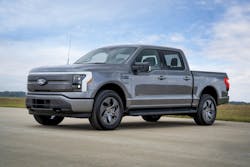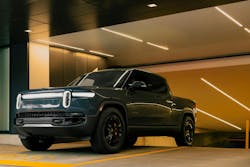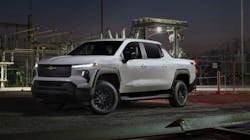In this article, you'll learn about:
- Some of the main features offered by the Ford F-150 Lightning Pro, the Rivian R1T, and the Chevy Silverado EV
- The real-world performance for each of these trucks
- Some of the maintenance needs for each vehicle
The heavy-duty sector has slowed its adoption of commercial EVs, with less than 1,700 deployed in the U.S. through 2024 and sales remaining flat for 18 months, according to CALSTART. But thanks to lower cost and more available charging, battery-electric pickups are finding a place in homes and fleets. Recent slump notwithstanding, Tesla sold nearly 39,000 Cybertrucks last year, per Cox Automotive. It’s not a fleet vehicle per se, but does outnumber the total number of deployed electric cargo vans in the U.S., the most successful commercial segment. The Ford Lightning was not far behind, with 33,510 sales, while the Chevy Silverado EV garnered just shy of 7,500 in its first full year. These numbers are nowhere close to their gas counterparts, but the EV field is getting larger slowly but surely.
While the reasons that fleets transition vary, they’ve all found similar benefits, including simplified and less costly maintenance, as well as independence from volatile fuel pricing. Here’s a quick glance at key features and what users are saying.
The Lightning, which shares certain design elements with the best-selling original F-150, came to market in 2022. Its zero-emission powertrain generates up to 580 hp, and 775 lb.-ft. of “nearly instant” torque, the OEM said. The Lightning tows up to 10,000 lbs. with the Max Trailer Tow Package and 5,000 lbs. at base, with a max range of 320 miles with the extended-range battery. The more you tow, the less you’ll go, though.
It offers a range of 240 to 320 miles (when spec’d with the extended-range battery), with a 15% to 80% charge in 32-38 minutes—and can tow from 5,000 to a maximum of 10,000 lbs. with the Max Trailer Tow Package. It features independent rear suspension and 8.4 in. of clearance.
Other features
Built with jobsite workers in mind, the pickup offers zone lighting and 9.6kW of onboard power available through 11 power outlets (including a 240V outlet) for equipment. The Power Reserve feature lets you set a minimum battery threshold when using onboard power so your crew doesn’t deplete the juice so much you can’t get to a charger (which the Ford Pro app identifies).
The electric pickup can also offer Ford’s suite of safety features with Ford Co-Pilot360. This includes pre-collision assist, blind spot monitoring, reverse brake assist, adaptive cruise control, intersection assist, and exit warning. It also features a 360-degree camera, Ford BlueCruise (hands-free driving), and Ford’s SYNC technology with over-the-air software updates.
Real-world operation
Falcon Towing, a California-based tow and AAA roadside assistance company, exclusively runs Fords, using 20 Ford Lightning pickup trucks in addition to seven E-Transits and 27 diesel-powered Ford F-550 tow trucks. The company chose to purchase EVs at the beginning of the decade due to rising fuel prices and unreliability at the fuel-provider level, according to Kam Najmi, Falcon Towing president.
“We just booked as many as we could, and whatever they had, we got,” Najmi said. “I think we got maybe five, six, or seven at a time ... and then we just started selling off all the previous [ICE] trucks.”
While Falcon’s towing operations are exclusive to its diesel-powered Ford F-550s, its roadside assistance operations, such as tire changes, lockouts, battery jump starts, and battery installations, are completed by Falcon’s light-duty vehicles—where the EVs have proven capable.
“From the day to day, I do like [the EVs] more, and they perform well,” Najmi said. “The technology on it is great. Good quality trucks.”
Running electric vehicles in Falcon Towing’s business operations came with initial challenges concerning range and charge management, however—especially because Falcon had not yet established on-site charging when it first took delivery of its Lightning pickups.
“We had to really see where we can charge them, how long does it take, and how to manage that,” Najmi said. “Then, obviously, since we have a lot of equipment on the trucks, it’s a little different, because the heavier the truck, the quicker [the battery] dies down.”
Najmi has also seen maintenance benefits with the Ford Lightning pickups. In fact, he said that “maintenance is just tires and brakes.” While preventive maintenance has been significantly reduced from Falcon’s previous ICE vehicles to its EVs, Najmi said it is necessary to keep a close eye on an EV’s tires, as EVs do tend to wear tires more quickly.
Charging
Charging was such a challenge for Falcon that its drivers would even grumble about its inconvenience and potential to lead them to lose out on customer calls. The problem required a management solution.
“Depending on how many chargers you have and how many trucks you have, you’ve got to have a set plan on the charging and the maintenance and making sure that you have a good system in place,” Najmi said.
And that plan will look different for every fleet. Falcon operates 24/7, and that means it needs vehicles ready at any moment.
Today, Falcon Towing has eight Ford Level 2 chargers on site, and its EVs use those on-site chargers and public charging when necessary.
Falcon Towing relies on Ford Pro’s vehicle monitoring software to manage charging, such as setting a charge time, limiting the capacity of charge, and viewing charger health alerts.
You might not immediately associate the R1T with the work truck sector, but its power suggests you should. It offers up to 1,025 hp, 1,198 lb.-ft. of torque, and a payload of 1,764 lbs. The 420-mile range and 11,000-lb. max towing best the Lightning (though at a $15,000 higher base cost). The ground clearance is 14.6 in., while the semi-amphibious vehicle can ford up to 3.5 ft. of water. The R1T has an independent suspension.
Other features
Furthermore, the pickup has received the Top Safety Pick or Top Safety Pick+ award from the Insurance Institute for Highway Safety since its launch in 2022—and is the only electric pickup truck to achieve that distinction. The R1T’s safety begins with its construction. It’s made from aluminum alloy, high-strength steel, and carbon fiber. But not only is it constructed with safety in mind, it boasts more than 20 safety features, including anti-roll control, radars, cameras, and sensors with safety-specific software. Camera views include a 360-degree view, backup camera, and blind spot monitoring.
Real-world operation
Rivian designed the R1T as an electric vehicle from the ground up, which is one reason Matt Cahir, CEO of Mevco, an upfitting company for the mining sector, chose to exclusively use the pickup for its builds. Due to a global push for more sustainable practices in the mining industry, the upfitter started by retrofitting F-150s, but that proved less-than-ideal.
When an internal combustion pickup is retrofitted as an electric pickup, “you end up with a vehicle that wasn’t designed to be what it is,” Cahir said. “You’ve got all that extra weight in the vehicle that it was never designed to have.”
He added a chassis built for an ICE-powered vehicle cannot protect an EV battery. In an industry where safety is paramount, the potential for battery damage posed a problem, Cahir said.
Desiring an electric pickup designed from the ground up, Mevco trialed the Lightning before turning to Rivian for its vehicle construction and software, which contributes to uptime.
“[Fleets] don’t want downtime,” Cahir said. “And they get a lot of downsides with ICE vehicles. Most mines that we’re talking to, 20 to 30% of their vehicles are out of service at any point. They’re sitting at the local dealership or at the workshop, waiting for a fit or a part.”
But with Rivian’s software, that wait time is drastically reduced, Cahir explained.
“Between Rivian and ourselves, we can see exactly what’s going on with the vehicle. We can diagnose it, typically before it happens with alarms telling us what’s going on. We can send—if we need to—a tech to the site or get a software update that resolves it and/or work through it over the telephone. It saves us a massive amount of money in maintaining and supporting our vehicles.”
An unexpected advantage of EVs in the mining industry is regenerative braking, as it produces less wear and tear on brake pads and rotors when vehicles are descending the steep grades within mines. But many EVs don’t implement regenerative braking if the battery level is too high. Fortunately, Rivian’s software allows owners to set charging limits, which Cahir said helps prevent runaway vehicles due to brakes getting “really hot really fast” when traversing those steep grades.
R1T maintenance
Not only does the software help prevent downtime, it helps that “there are 20 moving parts on an EV, [and] there’s 2,000 on an ICE,” Cahir said.
He also mentioned Rivian’s recommended maintenance schedule compared to an ICE vehicle. While Rivian suggests a tire rotation and multi-point tire inspection every 7,500 miles, other inspection recommendations aren’t until three years of use (brake fluid flush) or until 112,500 miles (coolant change and, for 2022-2024 Quad-Motor AWD vehicles, a drive unit fluid change). However, for Mevco’s R1Ts specifically, cabin air filters are changed on a much more frequent basis due to their operation in mines.
The Work Truck version of the Silverado EV features the most impressive range of any electric pickup out there, offering up to 492 miles on a full charge with the extended range battery. The powertrain generates up to 760 hp and 785 lb.-ft. of torque, with 12,500 lbs. max towing.
Four-corner air ride adaptive suspension is also available, offering a smooth ride.
“It is the smoothest I’ve felt while trailering a vehicle, because when you’re braking and stuff, you can kind of feel the weight distribute,” explained Aaron Skahen, a sales specialist at Serpentini Chevrolet in Westlake, Ohio, who test drove the EV at the Indianapolis Motor Speedway. “With the air ride suspension, you’re barely feeling anything.”
Other features
The WT is also available with technology perks, including a 17.7-in. infotainment screen, 11-in. information cluster, a 14-in. Head-Up display, and walk-up/walk-away lighting around the vehicle. It’s also available with General Motors’ Super Cruise, which allows operators to use hands-free driving on some roads.
Safety features include the Chevy Safety Assist suite of safety features as standard equipment, which offers automatic emergency braking, front pedestrian braking, lane keep assist, forward collisions alert, and more.
Real-world operation
To reduce Scope 1 emissions, SoCal Gas has converted 43% of its fleet (4,500 total units) to zero or near-zero emission powertrains, with 124 being Silverado EVs, according to Michael Franco, fleet financial and system manager at SoCal Gas.
“With fewer moving parts, reduced brake wear due to regenerative braking, and no need for oil changes, these vehicles require less maintenance over time, translating to lower fleet operating costs,” he explained.
He added the next-gen technology also “benefit[ted] our field crews in ways that were previously not possible.” For example, the driver-assist technologies and extended range improve field worker safety and operational effectiveness.
Franco did note drivers needed a 90-minute orientation to get used to the new features, as well as how to manage range and charging. The switch to high-voltage and additional diagnostic complexity also required technicians to attend some additional training.
About the Author

Jade Brasher
Senior Editor Jade Brasher has covered vocational trucking and fleets for the past five years. A graduate of The University of Alabama with a degree in journalism, Jade enjoys telling stories about the people behind the wheel and the intricate processes of the ever-evolving trucking industry.



